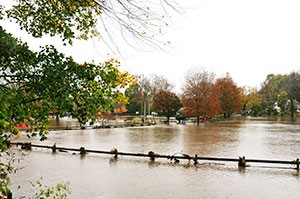Help flood cleanup workers avoid dangers

Floods are the cause of monumental damage to business and residential areas every year. Cleanup projects to restore communities can be dangerous, and environmental conditions are hazardous for workers. The Occupational Safety and Health Administration (OSHA) has published tips to help flood cleanup employees stay safe.
• Take regular breaks if lifting wet, heavy objects.
• Encourage good lifting techniques, work in teams when moving bulky items, and have a powered lift available for moving heavy items
• Workers in hot environments should take frequent breaks, have plenty of drinking water, sunscreen, and the proper heat stress relief products
• A first aid kit is important to clean and protect abrasions or cuts
• Regularly wash hands during the day and especially before drinking or eating
• Use a wooden stick or pole to check areas for holes, pits, and protruding objects before entering flooded areas
• Avoid entering flood-damaged buildings until these structures have been examined and certified as safe by a registered professional engineer or architect
• Properly secure all ladders and scaffolds before using
• Excavations, gullies, trenches, and washouts must be properly supported before entering
• Create a plan to contact medical personnel in the event of an emergency and provide training to educate workers about the plan
• Report downed power lines, gas leaks, and other hazards to supervisors and avoid performing work near these hazards
• Stay clear of electrical hazards
• Use fuel-powered generators only outdoors to avoid carbon monoxide hazards
• Coast Guard-approved personal floatation devices (PFD) are essential for workers in flooded areas, near rivers or bodies of water, and on docks
• Supply personal protective equipment (PPE), including protective clothing, watertight boots with steel toes and insoles, work gloves, safety glasses, hardhats, and NIOSH-approved respiratory protection especially when working where moisture problems and mold are present
• Clothing includes long pants, socks, and long-sleeved shirts
• Use insect repellent
• Avoid contact with wild or stray animals, especially rats and snakes
Reduce flood cleanup work risks by providing the appropriate safety products and training to protect workers. Make workplace safety a priority by evaluating work conditions, instituting effective policies and procedures, and teaching workers how to properly perform work in potentially dangerous environments.


